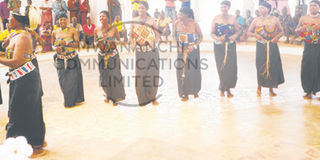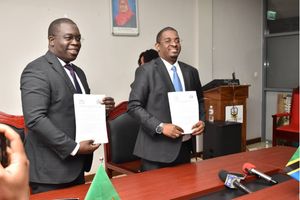TRAVEL : Four Corners Cultural Festival: A journey of understanding diversity

Women dance during the Four Corners Cultural Festival (4CCF), which was held during the third week of September 2016.
in Manyara region. PHOTO | ELISHA MAYALLAH
What you need to know:
- One, cultural celebration is all about sharing traditional lifestyles, unity, and sharing storytelling through dancing, drumming and singing. Two, I noticed that there is a distinctive sense of tremendously proud of the cultures sharing their wealth and traditional ways in a joyous atmosphere.
On a recent trip to Haydom, a rural town in Manyara region north of Tanzania, two seemingly related experiences got me thinking about cultural festivals and how they remain an admiration for many people.
One, cultural celebration is all about sharing traditional lifestyles, unity, and sharing storytelling through dancing, drumming and singing. Two, I noticed that there is a distinctive sense of tremendously proud of the cultures sharing their wealth and traditional ways in a joyous atmosphere.
The resilience of a cultural event in the face of rising modernity interest among the wider populace was kept alive in the four-day event of the Four Corners Cultural Festival (4CCF), which was held during the third week of September 2016.
To say that the 4CCF is Haydom’s obsession is not something of an understatement. To this day, Haydom remains an understated rural town, though one that has lent a degree of cultural celebrity by its local population. And a timeless favourite of locals is how keenly they are interested in introducing their wealth of culture to the visitors in a fun and celebratory mood.
Held each year, the festival draws local and visitors from far and near to enjoy a fantastic huge gathering as talents from artists and performers captivate the senses of the crowd, representing a renewal and celebration of life.
This time, in its 5th edition – it has turned out to be a packed event full of fun - promoted by the Tanzania Tourist Board (TTB).
Capitalising on its location Haydom is a cultural melting pot centre, in which the four popular ethno linguistics African tribes meet. These are the Bantu, Khoisan, Nilo-Saharan and the Afro-Asiatic.
In the neighbourhood the Bantus are represented by Waisenye, Wanyiramba and Wakimbu from Singida region; the Khoisan is represented by Hadzabes; While Datogas represent Nilo-Saharan and the Afro-Asiatic family is represented by the Cushitic Iraqw, locals based in the Haydom sprawling rural and laid-back town.
Haydom’s history has been coloured by centuries of a fusion of the popular African tribes, motivated by their passion and evolution. The cultures and influences are still very much alive and part of the local’s way of life.
A few notable things captured the imagination, an alluring moment to the young and old. One of it is the landmarks that make the 4CCF inviting and inspiring - the presentation of living traditional houses of the four popular African tribes, built in different areas of the 10 acres land.
“In order to make each tribe tied to their cultural heritage, the centre offer living houses according to their own traditional’, said Eliminata Awet, the coordinator of the Four Corners Cultural Programme (4CCP) the organizers of the event.
And closely linked is a museum that holds the tools in use and those used in the past millennia where visitors are allowed to visit and learn the great history that has evolved over time.
That first day and for the next three, people in hundreds strolled through the cool shadows of the open countryside of the culture centre just three km out of the town. And people from all walks of life swarmed the grounds and smiled enthusiastically as they watched a mix of cultural dances performed in competition, daily.
The highlighted group, this time, were the new Bantu entrant – the Wakimbu group from Singida region – the women dressed in black long skirts with topless wore the face of the first-rate traditional artists, in which their dance gave a stellar performance. Fathers lifted their children up over their heads to watch the frenzy women dancing in matching steps and styles.
Applause rang out endlessly from the crowd as archery, in which Hadzabes who are experienced to use a bow and arrow collected all the high points. While a famous stick fight mainly practised by the Iraqws (Ilgendi) won hearts and minds of locals who could not stop cheering one of their own.
The festival was a fantastic gathering to lift spirits and bring about hope and optimism into understanding the world of culture and part of their heritage.
Email: [email protected]




